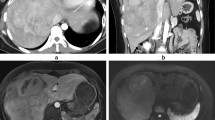Abstract
Hepatocellular adenomas have recently been classified into four subtypes based on molecular findings: hepatocyte nuclear factor 1α (HNF1α) inactivated, inflammatory/telangiectatic, β-catenin activated, and unclassifiable. β-catenin-activated adenomas have the potential for malignant transformation and are thus important to recognize. Diffuse glutamine synthetase immunohistochemical positivity has been shown to be a reliable surrogate marker for β-catenin activation, though variations in staining patterns may be difficult to interpret. We report a case of a peliotic adenoma that was morphologically consistent with a β-catenin wild-type hepatocellular adenoma but harbored a β-catenin mutation by molecular analysis. The tumor lacked nuclear β-catenin positivity and demonstrated a hitherto undescribed pattern of glutamine synthetase overexpression restricted to areas of peliosis with mostly negative staining in non-peliotic areas. This pattern was initially interpreted as physiologic and may represent a potential pitfall in glutamine synthetase interpretation.


Similar content being viewed by others
References
Zucman-Rossi J, Jeannot E, Nhieu JT et al (2006) Genotype-phenotype correlation in hepatocellular adenoma: new classification and relationship with HCC. Hepatology 43(3):515–524
Bioulac-Sage P, Rebouissou S, Thomas C et al (2007) Hepatocellular adenoma subtype classification using molecular markers and immunohistochemistry. Hepatology 46(3):740–748
Bioulac-Sage P, Laumonier H, Couchy G et al (2009) Hepatocellular adenoma management and phenotypic classification: the Bordeaux experience. Hepatology 50(2):481–489
Bioulac-Sage P, Cubel G, Taouji S et al (2012) Immunohistochemical markers on needle biopsies are helpful for the diagnosis of focal nodular hyperplasia and hepatocellular adenoma subtypes. Am J Surg Pathol 36(11):1691–1699
Gebhardt R, Baldysiak-Figiel A, Krügel V, Ueberham E, Gaunitz F (2007) Hepatocellular expression of glutamine synthetase: an indicator of morphogen actions as master regulators of zonation in adult liver. Prog Histochem Cytochem 41(4):201–266
Ueberham E, Arendt E, Starke M, Bittner R, Gebhardt R (2004) Reduction and expansion of the glutamine synthetase expressing zone in livers from tetracycline controlled TGF-beta1 transgenic mice and multiple starved mice. J Hepatol 41(1):75–81
Paxian M, Rensing H, Geckeis K et al (2003) Perflubron emulsion in prolonged hemorrhagic shock: influence on hepatocellular energy metabolism and oxygen-dependent gene expression. Anesthesiology 98(6):1391–1399
Stevens WE, Patil A. Vascular Disease of the Liver. In: Feldman M, Friedman LS, Brandt LJ, eds. Sleisenger and Fordtran’s gastrointestinal and liver disease. 9th ed. Philadelphia, PA: Saunders; 2010:1381
Cho SJ, Wanless I, Paradis V et al (2011) FNH-like lesions and glutamine synthetase expression in the liver in hereditary hemorrhagic telangiectasia (abstract). Mod Path 24:364A
Bioulac-Sage P, Cubel G, Balabaud C, Zucman-Rossi J (2011) Revisiting the pathology of resected benign hepatocellular nodules using new immunohistochemical markers. Semin Liver Dis 31(1):91–103
Bioulac-Sage P, Taouji S, Le Bail B, Possenti L, Balabaud C (2013) Value and limits of routine histology alone or combined with glutamine synthetase immunostaining in the diagnosis of hepatocellular adenoma subtypes on surgical specimens. Int J Hepatol 2013:417323
Austinat M, Dunsch R, Wittekind C, Tannapfel A, Gebhardt R, Gaunitz F (2008) Correlation between beta-catenin mutations and expression of Wnt-signaling target genes in hepatocellular carcinoma. Mol Cancer 7:21
Conflict of interest
The authors have no funding sources or conflicts of interest to disclose.
Author information
Authors and Affiliations
Corresponding author
Rights and permissions
About this article
Cite this article
Berry, R.S., Gullapalli, R.R., Wu, J. et al. Diffuse glutamine synthetase overexpression restricted to areas of peliosis in a β-catenin-activated hepatocellular adenoma: a potential pitfall in glutamine synthetase interpretation. Virchows Arch 465, 241–245 (2014). https://doi.org/10.1007/s00428-014-1620-8
Received:
Revised:
Accepted:
Published:
Issue Date:
DOI: https://doi.org/10.1007/s00428-014-1620-8




